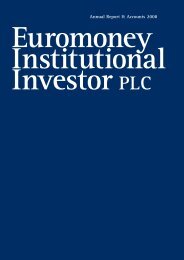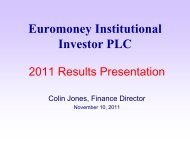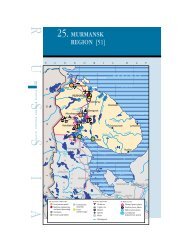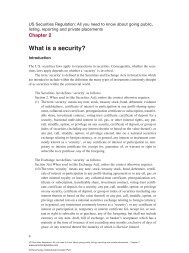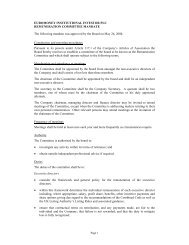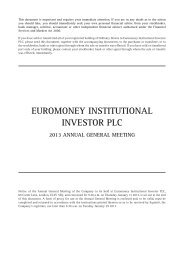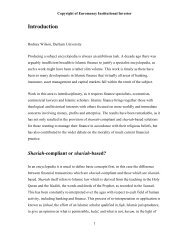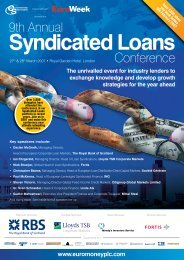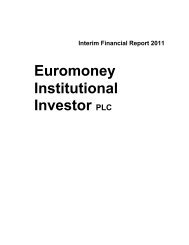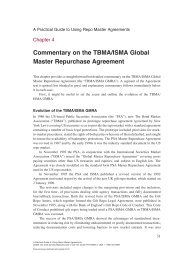Table of Contents - Euromoney Institutional Investor PLC
Table of Contents - Euromoney Institutional Investor PLC
Table of Contents - Euromoney Institutional Investor PLC
Create successful ePaper yourself
Turn your PDF publications into a flip-book with our unique Google optimized e-Paper software.
CONTENTSChapter 12: Asset/liability management <strong>of</strong> credit unions 162Ralph E. ReardonIntroduction 162Assessment methodology 162Evaluation <strong>of</strong> the ALM model and assumptions 165Core share valuation methodology 166Quantification <strong>of</strong> interest rate risk to capital 167Major assumptions 173Conclusion 174Part V: Asset/liability management <strong>of</strong> insurance companies 175Chapter 13: Creditworthiness and asset/liability management <strong>of</strong>insurance companies: a rating agency perspective 177Robert Riegel and Joel LevineIntroduction 177Rating methodology 177Qualitative factors 179Quantitative analysis 182Ratio analysis cannot capture all forms <strong>of</strong> financial risk 196Blending qualitative and quantitative factors 196Conclusions 197Chapter 14: Asset/liability management for life insurers:lessons learned and future directions 198Anson J. Glacy, Jr and Andres E. VilmsIntroduction 198Life insurance product types 198Life insurance investment practices 200Financial reporting considerations 201Historic metrics and methods 202The events <strong>of</strong> 2002 and their aftermath 207Future directions 208Conclusion 213Chapter 15: Portfolio benchmarks for property-casualty insurers:an asset/liability application 214James E. BachmanIntroduction 214The P&C industry and its common fixed-income benchmark 215ALM as a benchmark development tool 219Impacts <strong>of</strong> equities, changing underwriting results, and leverage 223P&C segment-specific customized benchmarks 226Summary 229viiiAsset/Liability Management <strong>of</strong> Financial Institutions: Maximizing Shareholder Value through Risk-Conscious Investing – <strong>Contents</strong>www.euromoneybooks.com© <strong>Euromoney</strong> <strong>Institutional</strong> <strong>Investor</strong> <strong>PLC</strong>
CONTENTSNature <strong>of</strong> funding 283Risks <strong>of</strong> funding level volatility 285Overlay portfolios that supplement asset allocation 286Managing the interest rate dimension <strong>of</strong> pension plan ALM 287Managing the equity dimension <strong>of</strong> pension plan ALM 287Combining equity and interest rate dimensions usingtwo-factor options 287Integration <strong>of</strong> pension plan with corporate balance sheet 289Conclusion 290Part VII: Asset/liability management <strong>of</strong> government-sponsoredenterprises and real estate companies 291Chapter 20: Asset/liability management at Fannie Mae 293Cherise McGovern, Peter Niculescu and William QuinnIntroduction 293Fannie Mae’s role and key characteristics 293Mortgage investment dynamics 295Measures <strong>of</strong> interest rate risk 298Interest rate risk management 299Conclusion 307Chapter 21: Asset/liability management at Freddie Mac 308Nazir Dossani, Peter Federico and Jan LuytjesIntroduction 308Background and investment management process 309ALM: identifying and measuring risk 312ALM: key models used in measuring risk 316ALM: managing and controlling risk 322Reporting and disclosure <strong>of</strong> risk 324Conclusion 325Chapter 22: Asset/liability management <strong>of</strong> real estatefinance companies 330Richard SheaIntroduction 330ALM dimensions <strong>of</strong> specialty real estate companies 332Commercial real estate finance companies 334Residential real estate finance companies 337Structural issues that affect ALM 339Conclusion 340xAsset/Liability Management <strong>of</strong> Financial Institutions: Maximizing Shareholder Value through Risk-Conscious Investing – <strong>Contents</strong>www.euromoneybooks.com© <strong>Euromoney</strong> <strong>Institutional</strong> <strong>Investor</strong> <strong>PLC</strong>
CONTENTSPart VIII: Regulatory and accounting aspects <strong>of</strong>asset/liability management 341Chapter 23: Regulatory environment overview 343Edward T. Hida II and Ahmet YetisIntroduction 343Depository and lending institutions 344Insurance industry 350Asset management industry 356Final remarks 358Chapter 24: Accounting standards and requirements 363Elias Habayeb and Sachin SethiSFAS-133: accounting for derivative instruments andhedging activities 363SFAS-115: accounting for certain investments in debt andequity securities 366SFAS-140: accounting for transfers and servicing <strong>of</strong> financialassets and extinguishments <strong>of</strong> liabilities 367SFAS-150: accounting for certain financial instruments withcharacteristics <strong>of</strong> both liabilities and equity 370Chapter 25: Implications <strong>of</strong> regulatory and accounting requirementsfor asset/liability management decisions 373Edward T. Hida II, Elias Habayeb, Ahmet Yetis and Sachin SethiHedging and derivatives accounting 373Investment accounting and liquidity management 381Securitization 382Accounting treatment <strong>of</strong> tier 1 and tier 2 capital items 383Asset/Liability Management <strong>of</strong> Financial Institutions: Maximizing Shareholder Value through Risk-Conscious Investing – <strong>Contents</strong>www.euromoneybooks.com© <strong>Euromoney</strong> <strong>Institutional</strong> <strong>Investor</strong> <strong>PLC</strong>xi



